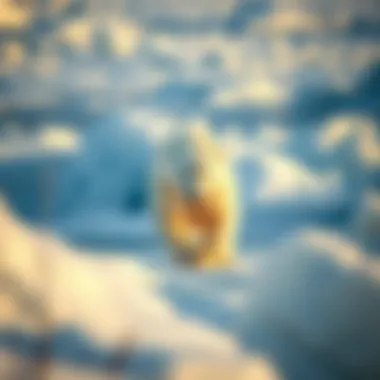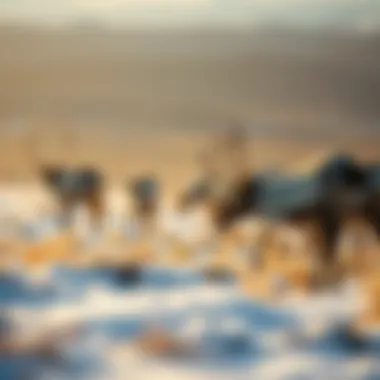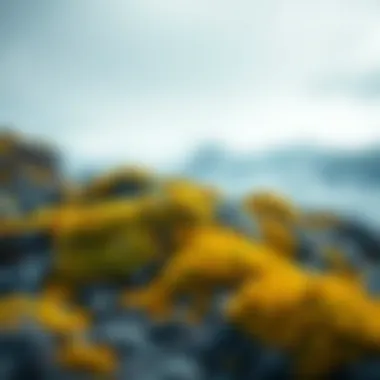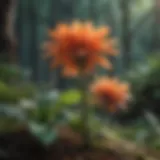Exploring the Unique Flora and Fauna of the Arctic


Nature Topic Overview
The Arctic region is not just a land of ice and snow; it is a vibrant habitat teeming with life. Many plants and animals here have adapted remarkably to survive the extreme cold and harsh conditions. From the towering icebergs to the diverse wildlife, the Arctic has a lot to offer. Let's embark on a journey to explore the various forms of life that thrive in this frigid environment.
In this guide, young readers will discover how various species — from the smallest mosses to the majestic polar bears — have developed unique strategies that help them live in the Arctic's unforgiving climate. This exploration will also shed light on the intricate relationships these species maintain within their ecosystem and the growing threats posed by climate change on their existence.
Fun Facts and Trivia
Here are some cool tidbits about the Arctic's flora and fauna that will amaze young explorers:
- The Arctic Tern is a bird that travels up to 44,000 miles each year, flying from the Arctic to Antarctica and back.
- Some Arctic species, like the Arctic poppy, only bloom for a few weeks each summer when the sun shines longest.
- The Arctic ground squirrel can actually go into hibernation for nearly 8 months!
To make this learning experience even more engaging, imagine using colorful visuals featuring Arctic landscapes and interactive elements, like a quiz to test knowledge on what you've learned.
Wildlife Explorations
In the Arctic, wildlife comes in all shapes and sizes. Here are some of the incredible species you might encounter:
- Polar Bear: The largest carnivore on land, these bears have thick fur and a layer of fat to keep warm. They roam vast distances looking for seals, their primary food source.
- Arctic Fox: With its fluffy white coat that provides camouflage against the snow, this small mammal loves to hunt lemmings and store food for the winter.
- Lichens and Mosses: These hardy plants can brave the cold. Lichens can grow on rocks and trees, absorbing water from the air, while mosses blanket the ground, creating a vibrant carpet of green in summer.
Interactive features like a fun quiz about the Arctic animals can enrich this experience and make learning memorable.
Environmental Awareness
Understanding the delicate balance of the Arctic ecosystem is crucial. Here’s why conservation matters:
- Climate Change Effects: As global temperatures rise, ice is melting and habitats are being destroyed. The polar bear population is dwindling because of habitat loss.
- Importance of Biodiversity: Every species plays a role in keeping the ecosystem stable. Losing one can lead to unexpected changes and complications.
Children can play their part! Simple actions like recycling, conserving energy, and spreading awareness about Arctic conservation can significantly help.
DIY Nature Activities
Engaging with nature can be fun! Try out these hands-on activities:
- Create Your Own Arctic Scene: Use cotton balls to simulate snow and plastic animals to create an Arctic habitat on a piece of cardboard.
- Arctic Animal Masks: Using paper plates, colors, and other craft supplies, make masks of your favorite Arctic animals.
- Nature Scavenger Hunt: If you’re near a park or nature reserve, try to find plants, rocks, or insects that remind you of the Arctic. You can even take photos and document your findings!
Every adventure helps deepen the understanding of the ecological role each species plays.
"Today’s youth are tomorrow’s stewards of the Earth. Encouraging them to connect with nature helps ensure a sustainable future."
Learning about Arctic flora and fauna is just the tip of the iceberg. It opens up avenues to explore sustainability and conservation efforts. Understanding the resilience of these species can inspire future generations to care for our planet.
Foreword to the Arctic Ecosystem
Understanding the Arctic ecosystem is like peeling back layers of an onion—each layer reveals not just beauty, but vital information about how life persists in one of the most challenging climates on Earth. The Arctic is home to a range of unique species that have adapted over thousands of years to survive the frigid temperatures and extreme conditions. By exploring this ecosystem, we can grasp the delicate balance that exists between flora, fauna, and climate.
Understanding the Arctic Climate
The Arctic climate is known for its harshness. Imagine living in a place where the sun may not rise for months, temperatures drop to staggering lows, and blizzards can whip up without a moment's notice. This environment shapes all life forms here.
The region experiences long winters, which can last from October to March, characterized by snow and ice covering the land and sea. These extreme conditions require plants and animals to develop specialized skills for survival. For example, plants like the Arctic willow grow low to the ground to escape harsh winds and harsh temperatures. Animals, such as polar bears, possess thick blubber and fur to keep warm, allowing them to navigate through the icy terrain.


"The Arctic ecosystem’s resilience is a testament to nature’s ingenuity, yet even the toughest species are feeling the heat from climate change."
Moreover, the Arctic faces the unique phenomenon of permafrost—ground that remains frozen year-round. As the temperatures rise, this layer begins to thaw, impacting everything from plant growth to animal habitats. The changing climate disrupts traditional migration patterns and food sources for many species, which will be further explored in the sections ahead.
Geographical Features of the Arctic
The geographical features of the Arctic are as fascinating as they are varied. This region boasts expansive ice sheets, glaciers, and an ever-shifting landscape shaped by the relentless forces of nature. Let's take a closer look at some of these defining characteristics:
- Ice Caps and Glaciers: The Arctic is home to massive ice caps, particularly in Greenland and parts of Canada. These frozen landscapes are not just stunning to look at; they play a crucial role in regulating the Earth's temperature.
- Archipelagos and Islands: Numerous islands, such as Svalbard or the Franz Josef Land, dot the Arctic Ocean, each with its own unique ecosystem. Some are rich in birdlife, while others provide breeding grounds for seals.
- Continental Shelves: The shallow undersea areas are teeming with marine life that relies on the rich nutrients brought by currents. Fish and crustaceans thrive here, forming the basis for a complex food web.
Understanding these geographical features is not just about appreciating their beauty; it’s essential for recognizing how interconnected these elements are with life in the Arctic. From the smallest mosses to the largest mammals, the environment shapes the adaptations and survival strategies that define the region’s inhabitants.
Flora of the Arctic
The flora of the Arctic is not just a collection of the hardiest plants hanging on in an otherwise unforgiving climate. It is a key player in the delicate balance of this unique ecosystem. Understanding these plants provides insights into the survival tactics of nature when faced with extreme conditions. In sunlight that only graces the land for a few short weeks, or when temperatures plummet to bone-chilling lows, these florae have found ways to thrive. Thus, recognizing their adaptations can deepen our understanding of life on Earth and the interconnections within the ecosystem.
Types of Arctic Plants
Arctic plants include an array of species that exhibit remarkable resilience. Here’s a glimpse of their diversity:
- Mosses: These small green patches cover the ground like a natural carpet. They can thrive in mere inches of soil, and their ability to absorb moisture from the air helps them survive long dry spells.
- Lichens: Distinctly known for their partnership between fungi and algae, lichens can withstand extreme cold, making them ideal companions in the Arctic habitat.
- Flowering Plants: Some brave souls bloom in the summer light, like the Arctic poppy, which can spring up, turning the usually barren landscapes into bursts of color for a fleeting moment.
- Perennials: These plants love sticking around. Species like the arctic willow grow low and make the most of short summers, often hiding beneath the snow in the long winter months.
These types of flora not only adapt to harsh conditions but also serve as food sources for animals, showcasing their vital role in the food web.
Adaptations of Arctic Vegetation
In the Arctic, it’s all about survival of the fittest, and the plants have adopted several clever strategies:
- Low Growth Forms: Many Arctic plants grow close to the ground, reducing their exposure to the biting wind and cold, much like children huddling together for warmth.
- Short Growing Seasons: These plants have honed the ability to grow quickly during the brief summer period. They may blossom and set seeds in just a matter of weeks.
- Antifreeze Proteins: Certain species have developed proteins that allow them to withstand freezing temperatures. It’s like having built-in protection against the frost that would kill a less-prepared plant.
- Deep Root Systems: While the surface may be frozen solid, roots can dig deep into the permafrost to access water and nutrients that are hidden away, ensuring survival even during tough conditions.
These adaptations set the stage for a remarkable survival story, where only the cleverest and toughest can endure.
The Role of Lichens in Arctic Ecosystems
Lichens serve as unsung heroes in the Arctic landscape. They often lead a quiet life but play a big role in maintaining ecosystem balance:
"Lichens, being a hybrid organism, contribute to soil formation and preserve moisture in an otherwise dry habitat."
- Soil Builders: Lichens help break down rocks, gradually turning them into soil suitable for other plants to thrive.
- Nutrient Providers: When they die, lichens decompose and replenish the soil with nutrients, supporting neighboring plants.
- Food Source: They offer a meal for a variety of Arctic herbivores, including reindeer.
- Indicators of Air Quality: Lichens are sensitive to air pollution. Their health can signal the environmental quality of their surroundings.
In short, these organisms are the linchpin of many Arctic ecosystems, silently ensuring that life continues in this cold and stark region. Through understanding the flora in the Arctic, we can gain insight into the resilience of life, even in the least forgiving of environments.
Animal Life in the Arctic
Animal life in the Arctic is a vital facet of this article, as it emphasizes the complex relationships and intricate systems that sustain life in one of the Earth's most extreme environments. The Arctic's unique wildlife has adapted through millions of years to survive the cold, often roaming over vast territories while relying on seasonal changes. Understanding these species not only showcases their resilience but also highlights the urgent need for conservation efforts in the face of climate change.
Mammals of the Arctic
Polar Bears
Polar bears are the undisputed icons of the Arctic. As apex predators, they roam across the sea ice in search of seals, their primary food source. A notable characteristic of polar bears is their remarkable sense of smell, which allows them to detect a seal nearly a mile away and beneath several feet of compacted snow. This unique ability makes them essential in maintaining the balance within the Arctic food web.
Their thick, white fur and a layer of blubber help them endure the chilling temperatures, while their vast range signifies the expansive territory they occupy. However, with climate change causing ice to melt at an alarming rate, polar bears are increasingly struggling to find enough food, truly making them a poignant symbol of the environmental threats facing the Arctic.
Arctic Foxes


Arctic foxes are small yet cunning animals that have adapted remarkably well to their frosty surroundings. Known for their thick fur that transitions from brown in the summer to white in the winter, they are masters of disguise amidst the snow. Their key characteristic lies in their incredible hearing, which helps them locate prey hidden under the ice.
Arctic foxes are also opportunistic feeders, enjoying a varied diet that includes lemmings, birds, and even carrion. This flexibility is crucial to their survival, especially when food is scarce. However, their reliance on lemmings as a primary food source makes them vulnerable to fluctuations in the lemming population, which can lead to food shortages in tough winters.
Seals
Seals are abundant in Arctic waters and play a significant role in the ecosystem. As marine mammals, they are well-adapted to life both on ice and in open water. Walruses and ringed seals, for instance, use ice as a platform for resting and nursing their young. The thick blubber and specialized fur allow them to insulate against cold temperatures.
Seals are also prey for polar bears but serve as crucial competitors for fish, further contributing to the dynamics of the food web. However, as the ice melts, their habitat is dramatically shrinking, which affects their breeding and hunting practices, raising alarms about their future.
Bird Species in the Arctic
Snowy Owls
Snowy owls are strikingly beautiful birds, often associated with the harsh beauty of Arctic landscapes. They are known for their distinctive white feathers - perfect camouflage against the snowy backdrop. This unique feature aids them in hunting lemmings and ptarmigans.
Moreover, snowy owls exhibit interesting behavior patterns; they tend to migrate southward when food is scarce in the Arctic. They symbolize the intricate balance of predator and prey within this chilly habitat. Changes in climate can disrupt their migration patterns, which can result in unexpected outcomes in their breeding success and overall population.
Arctic Terns
Arctic terns are remarkable for their long migrations from the Arctic to the Antarctic and back again each year. Known as champions of distance, they cover more than 70,000 kilometers annually. Their primary characteristic is their adaptability to various climates, as they thrive in both polar and temperate regions.
Their migratory habits contribute to the connectivity of ecosystems between different regions, highlighting the importance of international collaboration for their protection. Climate changes can interfere with their migration routes and feeding areas, underscoring the interconnectedness of wildlife across the globe.
Invertebrates of the Arctic
Arctic Krill
Arctic krill are tiny crustaceans that hold immense ecological significance. As a key food source for various marine species, including seals and whales, they are vital in the Arctic food chain. Their abundance helps to sustain the entire marine ecosystem, making them a focal point in discussions about Arctic biodiversity.
These small creatures are resilient and can withstand varying temperatures and salinity levels, which are crucial for their survival. However, they face threats from ocean acidification and rising temperatures, which can impact their population and, in turn, affect the species that rely on them.
Jellyfish
Jellyfish, often overlooked, play a role in the Arctic marine environment. These gelatinous beings are not just drifting through the currents; they are intricate players in the ocean's ecology. They serve both as prey for larger fish and invertebrates and control populations of other species through predation.
The unique feature of jellyfish is their ability to reproduce rapidly, which can be advantageous during favorable conditions. However, with warming waters, jellyfish blooms can disrupt the balance of marine food webs and threaten the species that depend on a more stable population cycle.
Understanding the animal life in the Arctic not only illuminates the remarkable adaptations of these species but also underscores the fragility of their ecosystems. Protecting these creatures is paramount in ensuring the survival of the Arctic's complex and interconnected web of life.
Interdependence of Arctic Species
The harsh conditions of the Arctic have forged a delicate but intricate web of life. Here, every species plays a crucial role, much like pieces in a giant puzzle. Understanding this interdependence helps shed light on not just how these species cohabit, but also how changes in one area can ripple through the entire ecosystem. In the Arctic, animals and plants are inextricably linked; the survival of each hinges on the existence of others. For instance, the mosses and lichens provide sustenance for caribou during the grueling winter months, while these same ungulates offer food for predators like wolves and bears.
Through this interconnectedness, the Arctic ecosystem maintains balance. Every organism has its part, from the tiniest shrimp scuttling along the ocean floor to the towering icebergs that cradle some of the season’s most spectacular sights.
"In nature, everything is process. Everything is interdependent."
Food Web Dynamics in the Arctic
The food web in the Arctic is a compelling example of life’s interconnected threads. At the base, we have primary producers: the resilient plants and algae. Throughout the icy waters, phytoplankton work tirelessly, converting sunlight into energy. Under the glare of a fleeting sun, these micro-organisms raise the curtain on the food chain, feeding small fish, which, in turn, become meals for larger fish such as the Arctic cod.
As we look further up this chain, one can easily see how species like seals depend on these fish. Without humans nearby, animal interactions dominate the essence of survival—for example, the polar bear’s hunting tactics rely on the availability of seals resting on the ice. Moreover, scavengers, like Arctic foxes, wait hungrily for remnants left by larger predators, highlighting the importance of every member within this intricate system.
This food web dynamics illustrates how a change in one species can send shockwaves throughout the entire Arctic ecosystem. If fish populations decline due to overfishing or changing temperatures, the ripple effect can diminish the food supply for seals, ultimately affecting the polar bears.
The Impact of Climate Change
As the world warms, the Arctic is experiencing some of the first and most apparent effects of climate change. Rising temperatures result in melting ice, which has dire consequences for the species relying on these ice-covered habitats. With the loss of sea ice, not only are seals losing basking grounds, but the entire food web faces disruption.
Melting Ice and Habitat Loss
Melting sea ice is probably the most stark indicator of climate change in the Arctic. Ice serves as a habitat for many species, making it an essential fixture of the landscape. Polar bears, for example, need solid ice for hunting seals. With the ice melting away during summer months, they find themselves with fewer places to hunt.


Additionally, melting ice also unlocks previously unreachable areas. As ice retreats, it alters the delicate balance of nutrients in the water. This encourages certain species to flourish while pushing others to the brink of extinction. Thus, the character of habitat loss presents itself not just as a physical space removal, but also as detrimental changes to the biological dynamics, making it a fitting focus of this article.
Effects on Species Migration
With the shifting climate, birds and mammals are adjusting their migratory patterns. Many species that traditionally relied on stable ice conditions are now searching out new routes. The change in timing of these migrations is notably significant. For instance, migratory birds may arrive at different times, potentially missing the peak availability of food sources.
Moreover, species like whales follow changing ocean currents, which may now expose them to greater risks, like entanglements in fishing gear or collisions with ships. This adaption process, however, is not uniform; while some species may thrive, others struggle to cope. Thus, the shift in migration routes due to climate affects interdependence, raising questions about long-term viability in Arctic ecosystems.
Conservation Efforts in the Arctic
The Arctic is like a beautiful, fragile gem, tucked away by our planet. Yet, it's facing some tough challenges due to climate change and human activities. Understanding conservation efforts is key for our future and the survival of countless species. These efforts are not just about saving animals and plants but also about maintaining the balance in this unique ecosystem.
Protected Areas and Reserves
In the Arctic, protected areas and reserves play a vital role in ensuring the survival of diverse wildlife and delicate ecosystems. These lands are where specific rules apply, helping to guard wildlife and their habitats from harmful activities.
- Sanctuaries for Wildlife: Many areas are designated as sanctuaries for species like polar bears and Arctic foxes. This protection allows these animals to breed and thrive without major disturbances.
- Research Opportunities: Protected areas often become sites for research. Scientists can study how these ecosystems change over time, which helps us understand the effects of climate change.
- Public Awareness: When people visit these natural parks, they learn about the importance of conservation, fostering a sense of responsibility towards nature.
However, even these protected areas face pressures, from climate shifts to tourism. It's crucial that local communities and governments continue to champion these lands and their wildlife.
Role of International Agreements
The fight for the Arctic is not just a local one; it involves the entire world. International agreements bring countries together to tackle the challenges facing this region, emphasizing collective responsibility.
Arctic Council
The Arctic Council is a key player in coordinating cooperation among Arctic nations. It focuses on issues like environmental protection and sustainable development.
- Unique Feature: One of its standout characteristics is that it includes indigenous communities. This gives a voice to those who have lived in the Arctic for ages, sharing traditional knowledge about land and wildlife.
- Benefits: Being involved in the Arctic Council allows countries to learn from one another and develop strategies based on shared knowledge and research.
Paris Agreement
The Paris Agreement is another cornerstone of global climate efforts that has implications for the Arctic. It aims to limit global warming to well below 2 degrees Celsius, with efforts to go even lower.
- Key Characteristic: The agreement encourages nations to commit to sustainable practices, impacting all regions, including the fragile Arctic.
- Advantages: By linking climate action with conservation, the Paris Agreement highlights the importance of protecting ecosystems.
"Conservation in the Arctic is more than a local concern. It is a global responsibility that we cannot ignore."
In summary, conservation is not just about saving the Arctic today—it’s about preserving it for future generations. The interplay of protected areas and international agreements highlights a path forward, showcasing that every action counts. This journey into the cold is about finding harmony and ensuring the Arctic’s beautiful ecosystems can thrive against the odds.
Closure: The Future of Arctic Ecosystems
The Arctic ecosystems stand at a crucial crossroads. Understanding their future is essential, not just for the region itself but for the entire planet. Climate change presents significant challenges, altering weather patterns and impacting species dependent on the cold environment. If we do not take action now, many unique species could face extinction.
Potential Outcomes of Continued Climate Change
The consequences of ongoing climate change can be alarming. As temperatures rise, ice caps and glaciers melt at unprecedented rates. This not only leads to habitat loss but also affects the salinity of seawater, impacting marine life that depends on stable conditions. Polar bears, for instance, are increasingly forced to swim longer distances to find food, putting their survival at risk.
Additionally, species like the Arctic tundra's iconic caribou may struggle to find food, as the landscape changes. Migration patterns of birds could also shift, leading to mismatched breeding seasons and food availability. The ripple effects of these changes can disrupt the delicate balance of the entire ecosystem.
As changes unfold, an unexpected number of species might become endangered, creating a knock-on effect that endangers the entire Arctic food web.
Importance of Ongoing Research and Education
Research holds the key to understanding the Arctic and finding solutions to the challenges it faces. Educating young minds about these ecosystems can inspire the next generation to take action and protect our planet. Many programs exist that bring awareness to the significance of the Arctic. Classroom activities, like virtual tours or projects, can immerse students in this unique environment.
Moreover, cooperation among nations through international agreements, such as the Arctic Council, helps place a spotlight on necessary conservation efforts. Engaging local communities in conservation projects is equally important; after all, they are the stewards of their homeland.
In summary, the future of Arctic ecosystems hinges on our collective understanding, research efforts, and commitment to education. By fostering awareness and action, we can help preserve this irreplaceable part of our world for many generations to come.







